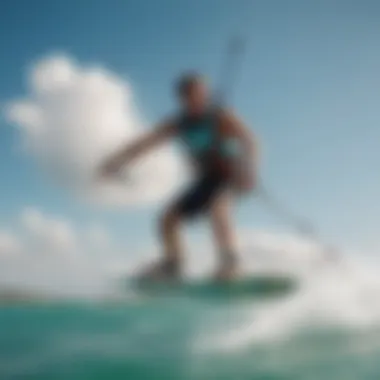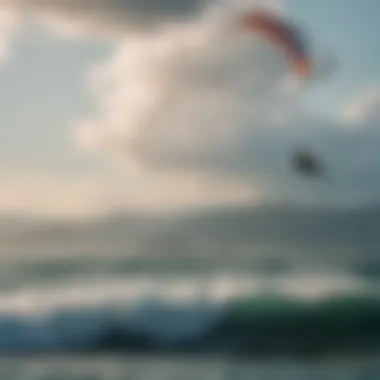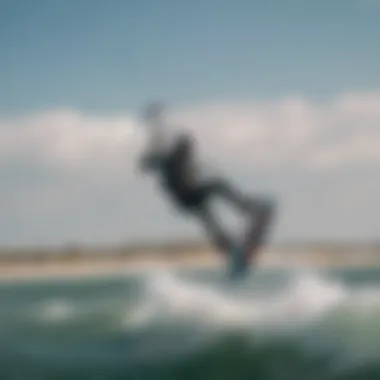Unleashing the Airtime: A Comprehensive Guide to Kiteboarding Mastery


Equipment Reviews
Kiteboarding enthusiasts always yearn for the latest advancements in kite models, eagerly anticipating enhanced performance and innovative features. In this section, we meticulously examine the diverse realm of kites, delving into an overview of the latest models. From distinctive shapes and sizes to the varied materials utilized, this analysis offers a comprehensive insight into the intricacies of kite selection. Furthermore, we dissect renowned kiteboarding brands, scrutinizing their unique attributes and individual performance capabilities.
Kites: Unveiling the Contrasts
Within the realm of kiteboarding, enthusiasts encounter a plethora of kite shapes that cater to different riding styles and wind conditions. Whether you prefer the versatility of hybrids, the speed of bow kites, or the stability of C-shaped designs, each shape holds its own distinct advantages. Additionally, the size of kites plays a pivotal role in optimizing performance, with larger kites excelling in lighter winds and smaller kites offering enhanced agility and speed. Material composition further influences a kite's behavior on the water, with options like ripstop nylon and polyester impacting durability and overall responsiveness.
Boards: Navigating Through Distinctions
Kiteboarding boards come in a myriad of designs, from the classic twintips to directional boards tailored for wave riding. Each board style integrates specific features to elevate the rider's experience, such as concave bottoms for better grip or rockered profiles for smoother navigation. Construction materials like carbon fiber, wood, or foam core directly affect a board's weight, flex, and durability, shaping its performance characteristics. Understanding the nuances of board design is crucial for selecting the most suitable option based on riding style, skill level, and personal preferences.
Accessories: Safeguarding Every Moment
Complete your kiteboarding setup with essential accessories that not only enhance performance but also prioritize safety on the water. Harnesses provide crucial support and control during maneuvers, while premium lines ensure reliable connection between kite and rider. Pumping equipment optimizes kite inflation for swift launch, while safety gear like helmets and impact vests offer vital protection during challenging conditions. By exploring the significance of each accessory in detail, riders can construct a comprehensive kit that maximizes enjoyment and minimizes risk.
Introduction
Kiteboarding, a thrilling water sport that blends elements of surfing and paragliding, has captivated adventure-seekers worldwide with its promise of catching airtime while riding the wind. This comprehensive guide explores the nuances of kiteboarding, offering insights and techniques for enthusiasts of all skill levels. From selecting the right kite to mastering mid-air maneuvers, this article delves into the art of harnessing the wind's power for exhilarating flights above the water.
Setting the Stage for Airtime Adventures
The Evolution of Kiteboarding
The evolution of kiteboarding traces back to the late 20th century, with pioneers developing rudimentary forms that have since transformed into the sleek and aerodynamic kites used today. This evolution has been marked by advancements in materials and designs, resulting in kites that offer enhanced stability, control, and lift. The evolution of kiteboarding has revolutionized the sport, allowing riders to achieve greater heights and extended airtime, pushing the boundaries of what is possible in this adrenaline-fueled pursuit.
The Thrill of Catching Air
The thrill of catching air in kiteboarding lies in the moment of weightlessness as riders launch off the water's surface, propelled by the wind and the lift generated by their kite. Experienced riders revel in the rush of adrenaline that accompanies each jump, as they soar through the air with a sense of freedom and exhilaration. This aspect of kiteboarding provides a unique blend of excitement and tranquility, as riders experience the sensation of flight while being fully connected to the elements.
The Essence of Airtime in Kiteboarding


Airtime is the essence of kiteboarding, embodying the freedom and creativity that this sport offers to enthusiasts. The ability to glide through the air, performing aerial maneuvers and tricks, encapsulates the essence of airtime in kiteboarding. It symbolizes the liberation from earthly constraints, allowing riders to defy gravity and gravity's limits discover new dimensions of movement and expression. The essence of airtime in kiteboarding captivates riders of all levels, drawing them into a world where the sky is not the limit.
The Fundamentals of Airtime
Kiteboarding enthusiasts are well aware that understanding the fundamentals of catching airtime is crucial in mastering this exhilarating sport. This section delves into the essential aspects of achieving significant airtime while kiteboarding, emphasizing the key components and techniques that play a pivotal role in soaring high above the waves.
Choosing the Right Kite
When it comes to kiteboarding, selecting the appropriate kite is paramount to a successful and thrilling experience on the water.
Understanding Kite Sizes
One of the fundamental considerations in choosing the right kite is understanding kite sizes. The size of the kite directly impacts its performance in different wind conditions and the rider's ability to catch optimal airtime. Larger kites provide more power and lift, enabling riders to soar higher, whereas smaller kites offer greater agility and speed. Understanding the nuances of kite sizes allows riders to select the most suitable option based on their skill level, wind conditions, and preferred style of riding.
Exploring Kite Designs
Exploring kite designs is another crucial aspect of choosing the right kite for kiteboarding. Various kite designs, such as bow kites, delta kites, and hybrid kites, offer distinct performance characteristics that cater to different riding styles and preferences. Each kite design has its unique features, such as depower ability, stability, and responsiveness, influencing the rider's overall experience on the water. By exploring different kite designs, riders can identify the one that aligns best with their riding goals and skill level, enhancing their ability to achieve impressive airtime and maneuvers.
Mastering Takeoff Techniques
Mastering takeoff techniques is essential for kiteboarders looking to elevate their aerial maneuvers and maximize airtime during their rides. Achieving a smooth and controlled takeoff sets the foundation for executing advanced tricks and maneuvers in the air, enhancing the overall experience of kiteboarding.
Timing is Key
In kiteboarding, timing plays a critical role in achieving a successful takeoff. Understanding the optimal timing for launching off the water in relation to the kite's movement and wind conditions is crucial for gaining height and control during aerial maneuvers. Proper timing enables riders to harness the power of the kite effectively, propelling them into the air with precision and energy. By mastering the timing of their takeoffs, kiteboarders can enhance their airtime experiences and execute maneuvers with confidence and style.
Utilizing Wind Conditions
Utilizing wind conditions to your advantage is a key factor in mastering takeoff techniques in kiteboarding. Being aware of how wind speed, direction, and gusts affect the kite's performance and lift is essential for achieving optimal airtime and control during takeoff. By adjusting their technique in response to varying wind conditions, riders can adapt their takeoff strategy to maximize height and hang time, resulting in more dynamic and exhilarating aerial maneuvers.
Navigating Mid-Air Maneuvers
Once airborne, navigating mid-air maneuvers is a thrilling aspect of kiteboarding that allows riders to showcase their skill and creativity in the skies. Executing controlled turns and exploring aerial tricks add complexity and excitement to the overall kiteboarding experience, challenging riders to push their limits and improve their aerial performance.


Executing Controlled Turns
Executing controlled turns while airborne is a fundamental skill that enables kiteboarders to change direction smoothly and maintain stability in the air. Controlled turns involve shifting the position of the kite and adjusting body positioning to execute precise and fluid maneuvers mid-flight. These maneuvers not only enhance the rider's control and balance in the air but also set the stage for more advanced aerial tricks and transitions. By mastering controlled turns, riders can elevate their mid-air navigation skills and unlock new possibilities for creative aerial sequences.
Exploring Aerial Tricks
Exploring aerial tricks adds an element of artistry and flair to kiteboarding, allowing riders to express their style and skill through dynamic and visually impressive maneuvers. From loops and rotations to grabs and flips, aerial tricks showcase the rider's creativity and technical proficiency in the air. Each aerial trick requires a combination of precise timing, body positioning, and kite control to execute seamlessly and with finesse. By experimenting with different aerial tricks and perfecting their execution, riders can expand their repertoire of maneuvers and elevate their airtime experiences to new heights, captivating spectators and fellow riders with their aerial prowess.
Safety Measures for Soaring High
Kiteboarding is a sport that thrives on adrenaline and pushing limitations, but safety should always remain a top priority. In this section, we will delve into the crucial topic of Safety Measures for Soaring High, emphasizing the significance of protective gear and precautions to safeguard against potential risks while chasing airtime adventures. Whether you're a novice or a seasoned kiteboarder, understanding and implementing essential safety measures can make a significant difference in ensuring a safe and enjoyable experience on the water.
Essential Safety Gear
When it comes to kiteboarding, having the right safety gear is non-negotiable. Proper equipment not only enhances performance but also plays a pivotal role in mitigating potential dangers that come with this exhilarating sport. Within this subsection, we will explore two fundamental aspects of essential safety gear that every kiteboarder should prioritize - Harnessing the Power of Harnesses and Ensuring Proper Helmet Fit.
Harnessing the Power of Harnesses
Harnesses are more than just accessories in kiteboarding; they are crucial pieces of equipment that provide support and control during high-flying maneuvers. The key characteristic of harnesses lies in their ability to distribute the pulling force of the kite across the rider's body, reducing strain on the arms and allowing for sustained control and stability while in the air. Kiteboarders often opt for waist harnesses or seat harnesses, each offering unique features tailored to different riding styles and preferences. Waist harnesses provide more freedom of movement, ideal for advanced riders seeking versatility in executing aerial tricks, whereas seat harnesses offer added lower back support and are favored by freeride enthusiasts for prolonged sessions on the water. Understanding the advantages and disadvantages of each harness type is essential in selecting the most suitable option based on individual comfort and performance requirements.
Ensuring Proper Helmet Fit
When it comes to high-speed water sports like kiteboarding, protecting the head is paramount. Ensuring a proper helmet fit is not only a matter of compliance but a critical safety measure to prevent head injuries in the event of falls or collisions. The key characteristic of a helmet lies in its impact-absorbing shell and inner padding, designed to cushion and safeguard the rider's head against impact forces. Choosing the right helmet size and ensuring a snug fit is vital to maximize protection and comfort. While wearing a helmet may not be a legal requirement in all kiteboarding locations, it is strongly recommended as a proactive measure to reduce the risk of head trauma and enhance overall safety on the water. Understanding the unique features of kiteboarding helmets and their advantages in protecting against potential head injuries reinforces the importance of prioritizing safety equipment in every kiteboarder's gear setup.
Maximizing Airtime Experiences
In the realm of kiteboarding, maximizing airtime experiences stands out as a pinnacle achievement for enthusiasts. It encapsulates the essence of freedom and adrenaline that drives individuals to pursue this exhilarating sport. By focusing on enhancing airtime, practitioners can delve into the intricacies of aerial maneuvers, pushing their skills to new heights. This section delves deep into the strategies and techniques necessary to elevate one's kiteboarding experience by prolonging and intensifying moments of flight.
Exploring Advanced Airtime Techniques
Pushing the Limits of Hang Time


Pushing the limits of hang time is a pursuit embraced by avid kiteboarders seeking to defy gravity and extend their time soaring through the air. It involves executing maneuvers that elongate the duration of flight, showcasing a symbiosis between rider and wind that culminates in extended moments of weightlessness. This facet of kiteboarding offers practitioners the thrill of suspended animation, allowing for unprecedented aerial feats that captivate both performer and spectator alike.
Enthusiasts are drawn to pushing the limits of hang time due to the unparalleled sensation of prolonged flight and the opportunity to showcase mastery over the elements. By harnessing wind dynamics and perfecting takeoff techniques, riders can challenge conventional notions of time in the air, achieving a sense of accomplishment that reverberates throughout the kiteboarding community.
Fine-tuning Aerial Control
Fine-tuning aerial control is a critical component of mastering kiteboarding maneuvers, enabling riders to navigate the skies with precision and finesse. This technique involves honing one's ability to adjust positioning, posture, and kite handling mid-air, ensuring fluidity in movement and responsiveness to changing wind patterns. By refining aerial control, kiteboarders can execute complex turns, spins, and flips with seamless grace, elevating the visual and technical aspects of their performance.
The allure of fine-tuning aerial control lies in the mastery it affords individuals, empowering them to express their creativity and skill through elegant aerial displays. By attaining heightened levels of control, riders can transcend traditional boundaries of kiteboarding, crafting a narrative of artistry and athleticism that resonates with both practitioners and spectators. As riders strive to perfect their aerial maneuvers, the pursuit of refined control becomes a journey of self-discovery and achievement, propelling kiteboarding into a realm of limitless possibilities.
Embracing the Thrill of Big Air
Allowing oneself to be engulfed by the immense power of wind swells is a core tenet of kiteboarding, showcasing the symbiotic relationship between rider and nature. Riders who embrace the thrill of big air are propelled to dizzying heights, surrendering to the forces of nature while exerting mastery over their trajectory. This section explores the exhilaration and challenges inherent in chasing wind swells and adapting to ever-shifting environmental conditions, providing insights into the dynamic nature of kiteboarding at its pinnacle.
Chasing Wind Swells
Chasing wind swells necessitates a deep understanding of wind patterns, wave dynamics, and spatial awareness, allowing riders to harness the energy of nature's movements. By strategically positioning oneself to ride the crests of incoming swells, kiteboarders can catapult themselves to new altitudes, executing breathtaking aerial maneuvers that showcase the harmonious interplay between rider, wind, and water. This aspect of kiteboarding appeals to thrill-seekers and adventure enthusiasts alike, offering a visceral connection to the elemental forces that govern our world.
The unique feature of chasing wind swells lies in the exhilarating rush of propelling oneself to greater heights through sheer momentum and skillful manipulation of environmental cues. By capitalizing on wave formations and wind dynamics, riders can transcend traditional notions of flight, engaging in a dance of fluid motion and calculated risk-taking that defines the essence of kiteboarding's allure. Although challenging, the rewards of chasing wind swells are immeasurable, as riders forge a profound connection with nature while experiencing the sheer ecstasy of defying gravity.
Adapting to Changing Conditions
Navigating the ever-changing landscape of environmental conditions is a fundamental aspect of kiteboarding, demanding adaptability and foresight from riders. Those who excel in adapting to changing conditions possess the ability to fluidly adjust their strategies and techniques in response to shifting wind speeds, wave heights, and atmospheric variables. By embracing the unpredictability of environmental elements, kiteboarders can strengthen their skills, expand their repertoire of maneuvers, and enhance their overall proficiency in the sport.
The significance of adapting to changing conditions lies in its role as a catalyst for growth and innovation within the kiteboarding community. As riders confront unique challenges posed by fluctuating weather patterns and natural phenomena, they are compelled to hone their adaptability and problem-solving skills, fostering resilience and versatility in their approach to the sport. By embracing change as an opportunity for learning and development, kiteboarders can cultivate a mindset of continuous improvement, ensuring their readiness to tackle any obstacle that comes their way.
Conclusion
In the world of kiteboarding, the topic of conclusion holds significant importance as it encapsulates the overall essence and key takeaways from the entire journey of unleashing the airtime. Bringing together all the knowledge gained about kite selection, aerial techniques, safety measures, and maximizing airtime experiences, the conclusion serves as a pivotal moment for enthusiasts. It solidifies the learnings and instills a sense of achievement and progress. By reflecting on the adventures in the air and embracing the freedom of flight, participants can internalize their growth, successes, and challenges, paving the way for further improvement and refinement of skills.
Soar with Confidence
Reflecting on Airtime Adventures
Reflecting on airtime adventures is a crucial aspect of the kiteboarding experience, allowing enthusiasts to introspect and learn from their performances. It provides a platform for self-evaluation and growth, where individuals can analyze their techniques, decisions, and outcomes. This reflective practice enhances skills by identifying strengths to build upon and weaknesses to address. Embracing a mindset of continuous improvement, kiteboarders can elevate their performance levels through insightful reflection on each airtime adventure. This aspect adds depth and introspection to the overall kiteboarding journey, fostering personal development and skill enhancement.
Embracing the Freedom of Flight
Embracing the freedom of flight in kiteboarding is a transformative experience that offers participants a sense of liberation and pure exhilaration. The freedom to soar through the air, disconnected from the constraints of gravity, is a liberating sensation that fuels adrenaline and passion. It represents the ultimate expression of autonomy and control, where kiteboarders dictate their path and maneuvers in harmony with the wind. This aspect of kiteboarding encapsulates the true essence of the sport, symbolizing the pursuit of freedom, adventure, and self-expression. While embracing the freedom of flight brings unparalleled joy and thrill, it also demands respect for the elements and a commitment to continuous learning and growth.







